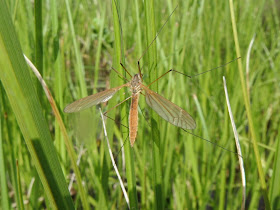I was out at a local wetland a few days ago and was witness to a small cranefly hatch. Most people have seen an adult cranefly and may not even know it - they are most often mistaken for giant mosquitos.
Craneflies (Tipulidae) are two winged insects in the Order Diptera (true flies). This order not only includes the family Tipulidae, but also a few families more familiar to fly anglers: Midges (Chironomidae) and Mosquitos (Culicidae).
Like all Diptera, craneflies undergo complete metamorphosis. They start out as wormlike larvae burrowing in mud or damp soil where they feed on decomposing debris (although a few species are predatory - eating small worms or midge larva). The terrestrial or shallow water habitat of most Tipulidae larva make them unavailable to trout most of the time; but they can sometimes be found in the drift during high water. Their large size (up to 50 mm long) make them a tasty mouthfull to any trout, and a larva pattern can be effective as stream levels drop after a rain.
.jpg) |
| Tipula sp. larva from the Red Deer River |
When the larva matures, it will enter the pupa phase. Many species pupate in damp soil along the stream bank or lake margin while others pupate under logs or rocks just below the waterline. Emergence is an event that trout rarely get to witness making emerger patterns inconsequential. The large adults can sometimes be seen clambering along the water surface and are sometimes taken by trout opportunistically.
.jpg) |
| Tipulidae (just starting to emerge) |
.jpg) |
| You can see the pupal shuck just under the waters surface on the left |
 |
| Tipulidae (emergence almost complete) |
.jpg) |
Tipulidae (teneral adult) shortly after emerging &
waiting for wings and exoskeleton to harden |
.jpg) |
| Tipulidae (adult) |
.jpg) |
| Tipulidae (male & female in copula) |
I did not collect a specimen so I can not say for sure what the genus or species is.
.jpg)
.jpg)
.jpg)

.jpg)
.jpg)
.jpg)


No comments:
Post a Comment